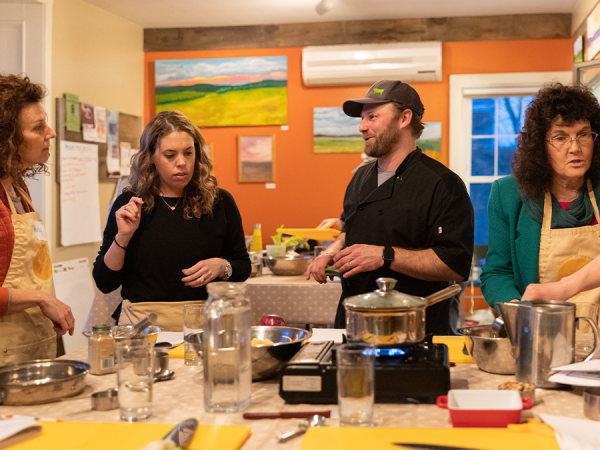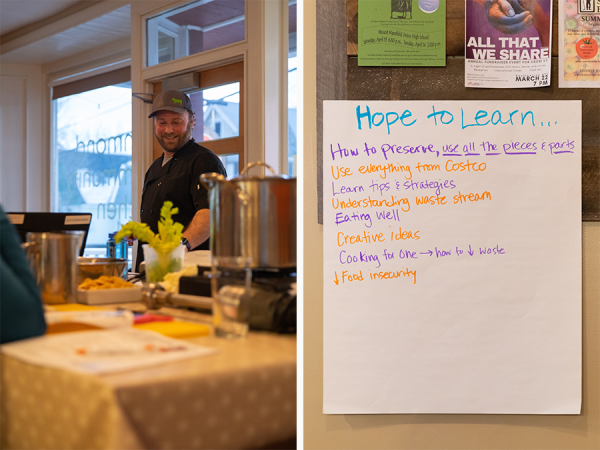Moroccan spices?
Decrease Food Waste with an "Anti-Recipe" for Moroccan Chickpea Stew
While teaching a Chinese cooking class, I noticed one of my students doing something strange as he was working through the recipe I handed out. He had chopped up an entire scallion, and was measuring out just enough to precisely fit in a tablespoon. When I asked him what he was going to do with the excess, he stared blankly and replied, “Well, throw it in the compost I guess...”
I chuckled a little and let him know it was ok to add it all into the pan. At first I chalked it up to inexperience, but then realized it was my fault the recipe read that way. I had written it, after all. In reducing this recipe from the original that yielded many more servings, large amounts of each ingredient had been cut to small, tedious measurements. I hadn’t considered how much opportunity for food waste I had introduced by quantifying amounts in small volumes instead of units of ingredients (i.e one tablespoon of scallion versus one chopped scallion).
And this got me thinking: what was I really trying to accomplish with my classes? Did I want to teach people to follow recipes, step-by-step, blindly? No, I want to empower homecooks to look at recipes like a chef: a flexible list of ingredients that are combined in a specific way to create a dish. Thus the idea of ‘anti-recipes’ was born.
‘Anti-recipes’ are nothing new. Chefs have been cooking this way for centuries. Old recipes often call for unmeasured amounts of ingredients: a dollop of this, or a scant of that. This type of recipe forces cooks to really consider the effect of every ingredient in the complete dish. Bakers do this every day; breads require more water in the drier winter months than in the more humid summer months, so they adjust the recipe based on how the dough feels. But this sort of adaptive cooking seems foreign to many of my students.
Following recipes to the T (for tablespoon, haha) creates wasted food. Have you ever measured out a half cup of chopped pepper, wrapped the remainder up, and rediscovered it two weeks later, molding, in the back of your fridge? Of course! Why not just chop the whole thing up and add it all into the pan? I doubt very much that an extra half pepper will ruin a stir fry or romesco sauce.
I’ve begun using the concept of anti-recipes in all my classes. They consist of a list of ingredients, prepped in a certain fashion, combined to make a dish. They’re very similar to a standard recipe, except they only contain ingredient amounts that are truly important to the final flavor profile or consistency of the dish.
My Moroccan Chickpea Stew is a great anti-recipe to try out. It calls for all sorts of vegetables — a perfect way to empty out the fridge of all that produce before it has to head to the compost. And when recreating this delicious hearty soup, as so many of my students still do, you might be tempted to turn to me and ask, “Do you think it needs more of the seasoning?” to which I’ll reply, “Take a taste. What do you think?”
Moroccan Chickpea Stew
Ingredients
- Ground beef, lamb, or pork (optional)
- Onion, large dice
- Red pepper, large dice
- Root vegetables, large dice
- Potatoes and/or sweet potatoes, large dice
- Other vegetables, large dice
- 1 cup apricots, halved
- 1 small jar green olives, sliced
- 1 large can diced tomatoes
- 1 large can chickpeas
- Water or stock
- Tomato paste
- Moroccan spices
- Cinnamon
- Cilantro, rough chopped
Directions
- In a large pot, brown the meat. Once cooked through, add the onions, peppers, and root vegetables. Cook over medium heat with a little salt until they become translucent. Add the potatoes, sweet potatoes, apricots, olives, tomatoes, and chickpeas to the pot and add enough water to just cover. Bring to a simmer and cook until the potatoes are tender.
- Add the spices and enough tomato paste to thicken the cooking liquid slightly. Check for seasoning and add salt if needed. Serve in a large bowl and garnish with plenty of the chopped cilantro. Serve with couscous.

